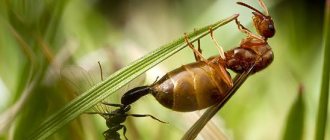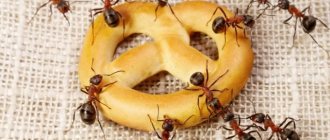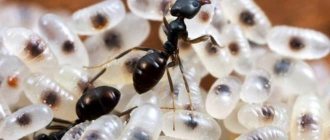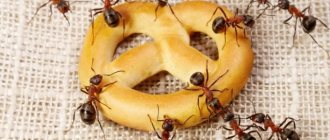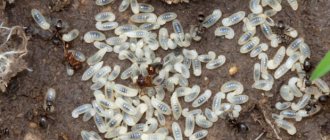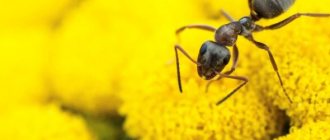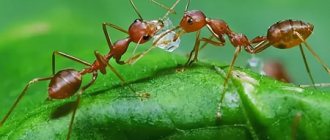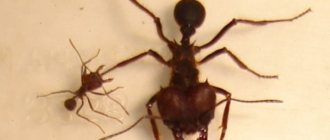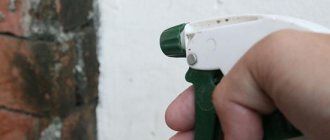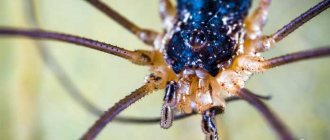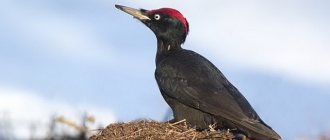Ecology
The brain is an amazing and perhaps the most mysterious organ, a small biological computer
, the center through which living beings receive commands for action.
The brain of animals varies greatly depending on the species and can be a small collection of nerve cells or a complex and amazing system of neurons
.
We invite you to find out the most interesting facts about the brain of animals and humans.
, which may surprise you a lot.
Spider brain
Spider brain
sometimes so large that
it displaces other organs
, which in some cases can move to the lower limbs.
The Smithsonian Tropical Research Institute
made this discovery while studying the nervous system of the world's smallest spider.
His brain occupies 80 percent
of his body cavity.
The most unusual features of spiders
Scientists have found that the smaller the animals, the larger their brains
in proportion to the rest of the body.
For example, the human brain makes up only 2-3 percent
of the total body weight.
In some small ants, the brain takes up 15 percent
, and in tiny spiders it is even more.
A little bit of history
At different stages of human development, the size of his brain changed greatly. For example, in Pithecanthropus it weighed about 900 cm3, and as humans developed, the brain mass increased to 1225 cm3, today the same figure is typical for a woman. Cro-Magnons had the largest brain - 1880 cm3. Today, its maximum mass in humans is 1445 cm3.
This is interesting! It is believed that Turgenev had the largest brain among people.
Leech brain
Leeches
may seem to you unattractive and even disgusting living creatures that are capable of clinging to the skin of humans or animals and
sucking their blood
. This property of leeches is often used in alternative medicine, for example, it helps clean infected wounds.
The most unusual types of therapy
It cannot be denied that leeches are amazing creatures, because they have 5 pairs of eyes, 300 teeth and..32 brains
! However, technically they have one brain, which consists of 32 nerve ganglia, which are actually separate brains.
Owners of the largest brains
Scientists took into account the ratio of brain mass to body mass of creatures to identify those with the largest brains. The record holder among vertebrates was a tiny hummingbird, as its ratio was 1/12. Invertebrate organisms showed different results, since they do not have a brain at all, but have a large number of nerve plexuses and endings. If we take into account the mass of nerve ganglia, the best result was that of the ant, its indicators were 1/4.
On a note! If we bring a person to this ratio, then his head would be simply huge, 8 times larger than at the moment, and its weight would be 20 kg.
Small giant squid brain
Giant squid
When feeding, they bite off relatively small pieces of food, since when swallowing, the food must pass through their
brain in the shape of a donut
, and only then enter the esophagus.
This gigantic creature has the largest eyes
of any creature on the planet, but its brain is surprisingly small.
Why do giant squids have such large eyes?
A male giant squid uses its 15-gram brain
to coordinate his 150-kilogram body. The length of this giant reaches 10 meters, and its genital organ reaches 1.5 meters in length.
Fungi are parasites that infect the brains of ants
Ant brain
may be affected by a special type of
parasitic fungus
called
Cordyceps unilateral
.
It infects ants, turning them into zombies
, manipulating their behavior, forcing them to leave the colony in order to spread and increase the number of their spores.
10 incredible facts about ants
Cordyceps
feeds on some non-vital organs of the ant,
entangling the brains of poor insects with its threads
, forcing the ants to climb to the tops of plants. After some time, the fungus kills the ant and grows as a mushroom from its head. Typical horror movie plot.
By the way, as studies of ancient fossils have shown, these fungi have parasitized ants since time immemorial: fossils dating back 48 million years
!
Smallest insect nervous system
Tiny wasp
The species
Megaphragma mymaripenne
is smaller in size than a single-celled
amoeba
, despite the fact that it has body parts such as
eyes, brain, wings, genitals and a digestive system.
Researchers have discovered that she has the tiniest nervous system ever
of all known insects.
A wasp's head contains a relatively small number of neurons when it is a larva, but later, when the wasp becomes an adult, the number of neurons is further reduced
as there is not enough room for them in its small head.
However, she doesn’t need a lot of brains: adult individuals live no more than 5 days
.
Deborah Gordon: What we can learn from ants about the brain, cancer and the Internet
I study ants in the desert, in the rainforest, in my kitchen and in the hills around Silicon Valley where I live. I recently realized that ants interact differently in different environments, which got me thinking that we can use them to study other systems, such as the brain and the data networks we create, and even cancer.
All these systems have in common the absence of a control center. An ant colony consists of sterile female workers, the ants we see around, and one or more fertile queens that just lay eggs. They don't give any orders. Even though they are called queens, they do not tell anyone what to do. An ant colony, where there are no managers, and similar systems without a control center are regulated by simple interactions. Ants communicate through smells. They smell with antennae, and they communicate with antennae. When one ant comes into contact with the antennae of another, it can learn, for example, whether the other ant belongs to the same anthill, and what kind of work the other ant is doing. Here you see many ants moving and interacting in a laboratory area that is connected by tubes to two other areas. When one ant meets another, no matter what kind of ant it meets, they are not actually communicating any complex signals or messages. The only important thing for an ant is the place where it meets other ants. And all these interactions taken together form a network. This is the ant network that you just saw moving around the site, and this constantly moving network determines the behavior of the colony, such as whether all the ants are hiding inside the anthill, and how many of them are going out in search of food. In fact, this is how our brains work, but the great thing about ants is that you can observe the entire network.
There are over 12,000 species of ants in every possible environment, and they use interactions in different ways to successfully withstand environmental conditions. One of the environmental challenges that every system faces is the maintenance costs, those required to keep the system running. And another challenge that the environment poses is resources, their search and collection. In the desert, maintenance costs are high because water is scarce, and the seed-eating ants I studied in the desert have to spend water to get it. The ant, being outside in search of food, searches for seeds under the scorching sun, thereby losing water evaporating into the air. But the colony obtains water by converting fats from the seeds they eat. In these environmental conditions, interaction is necessary to collect food. A forager ant going on a search will not go out until it receives enough information from the returning foragers. Here you see the returning collectors passing through the tunnel into the anthill, who meet the exiting collectors on their way. This is very important for the colony because the more food there is outside, the faster the foragers will find it, and the faster they will return, and the more foragers they can send. The system continues inexorably until improvements occur.
Thus, interactions trigger the foraging process. We studied the development of this system. First, there are differences. It turns out that colonies are different. On dry days, some colonies search for food less actively, so colonies vary in how they choose the optimal balance between spending water searching for seeds and obtaining water in the form of seeds. And we're trying to understand why some colonies search for food less than others by treating ants like neurons, using neuroscience models. Once a neuron receives signals from other neurons, it decides whether to transmit excitation; the ant receives signals from other ants and decides whether to go in search of food. We are looking for the possibility that there may be slight differences among colonies in how many interactions each ant needs before it goes out foraging, since a similar colony will receive less food.
And here a similar question arises about the brain. We're talking about the brain, but of course every brain is a little different, and there may be some people and some conditions in which the electrical properties of the neurons are such that they require more signals to fire, and this can lead to differences in brain function.
To ask questions about development, we first need to know about reproductive success. This is a map of the study region where I tracked the harvester ant population for 28 years, which is about as long as the colony has been alive. Each circle is a colony. The size of the circle shows the size of the offspring. We were able to trace genetic changes to compare parent and daughter colonies, and we found out which colonies were created by daughters of queens and from which parent colonies. And what was my amazement after all these years to find out, for example, that colony 154, which I knew well for many years, was my great-grandmother. Here is its daughter colony, and here is its granddaughter colony, and here are its great-granddaughter colonies. As a result, I was able to determine that the offspring colonies are similar to their parent colonies in their decision of which day is considered dry and not to go out in search of food; the descendants of the parent colonies live so far apart that the ants never meet, so the ants of the descendant colonies cannot learn this from the parent colonies. And our next step is to search for the genetic changes responsible for this similarity.
Then I could ask: who is better? At the time of my study, especially the last 10 years, there was a severe and prolonged drought in the southwestern United States, and it turned out that colonies that conserved water, stayed inside on very hot days, and thus sacrificed potential food, were more likely to have descendant colonies. All this time I thought that colony 154 were failures because on very dry days they only had a small amount of food while the other colonies were outside collecting a lot of food. But in reality, Colony 154 was a huge success. She is the matriarch. She is one of the few great-grandmothers in the region. To my knowledge, this is the first time we have been able to track the ongoing development of collective behavior in a natural population of animals and learn what works best.
The Internet now uses an algorithm to manage data flows very similar to what harvester ants use to manage harvester flows. Guess what we call this analogy? The internet is coming. [from English ant] Data does not leave the source computer until it receives a signal that there is enough bandwidth to move the data. In the early days of the Internet, when operating costs were high, it was very important not to lose data, so the system was configured with interactions to enable data transfer. What's remarkable is that the ants use an algorithm very similar to the one we recently created, but it is only one of many ant algorithms that we know about. Ants have had 130 million years to develop a lot of good algorithms, and I think it's clear that some of the other 12,000 species have interesting algorithms for data networks that we haven't even thought of.
What happens when the cost of living is low? Maintenance costs are low in the tropics as it is very humid and ants can easily be outside to search. But ants are so common and diverse in the tropics that there is a lot of competition. Whatever resource one species is using, another species is likely also using it at the same time. In these conditions, the interaction is applied in reverse. The system works until something negative happens. One species I study follows contours in trees where ants forage, moving from the anthill to the food source and back again, circle after circle, until something negative happens, like an interaction with ants of another species. Here is an example of an ant security system. An ant is in the center, blocking the entrance to the nest with its head as a result of interactions with other species. Those little ants are crawling around with their bellies up. But as soon as the threat disappears, the entrance opens again. In computer security, there may be situations where operational costs are low enough that we can simply temporarily block access in response to a sudden threat and then reopen it instead of trying to install an always-on firewall or other protection.
Another environmental challenge that every system faces is resources, their search and collection. To accomplish this, ants solve the problem of collective search, and this is a problem that robotics is now actively interested in, as we have realized that rather than sending one complex, expensive robot to explore another planet or search a burning building, it is much more efficient to use a group of cheaper ones. robots that transmit only the minimum necessary information. This is exactly how ants do it. The aggressive Argentine ant creates an extensive search network. They deal well with the fundamental problem of collective search, which is the trade-off between searching thoroughly and covering a large area. And this is what they do: when there are a lot of ants in a small space, each one searches very carefully, since there is another ant nearby, searching in the same place; but when there are few ants over a large area, they need to stretch out their routes to cover a larger area. I think they use interactions to judge distance, so when they're really crowded they meet more often and they search more thoroughly. Different ant species must use different algorithms because they evolved with different resources. Learning about this would be really useful, and we recently proposed that ants solve the problem of collective search in extreme zero-gravity conditions on the International Space Station. When I first saw this picture, I thought, “Oh no, they installed their home vertically,” but then I realized that, of course, it didn’t matter. The idea here is that it is harder for ants to cling to a wall, or floor, or whatever you want to call it, so they interact less, and there would be no relationship between how crowded they are and how often they collide. We are still analyzing the data. I don't have any results yet. But it would be interesting to know how other species cope with this problem in different conditions on Earth. To do this, we have set up a program that allows children around the world to try experiments with other species. It's very simple. Cheap materials can be used for this. In this way, we could create a global map of collective ant search algorithms. I think that most likely the invasive species, the ones that have come into your homes, are really good at this because they are in your kitchen and they are very good at finding food and water.
The most familiar resource for ants is picnic, and it is a grouped resource. One fruit is likely to have another fruit nearby, and ants that specialize in grouped resources use interactions to recruit recruits. When one ant collides with another or finds chemicals left on the ground by another ant, it changes its movement in the direction of the interaction - so you can end up with a column of ants sharing a picnic with you.
In a place like this, I think we could learn something about cancer from the ants. First, we can obviously do a lot to prevent cancer by prohibiting the distribution or sale of toxins that cause cancer in our bodies. But I don't think ants can help us much here, since ants never poison their colony. But we can learn something from them that can help treat cancer. There are many types of cancer. Each originates in a specific part of the body, and some cancers will then spread or metastasize to other tissues where they can receive the resources they need. If we look at the situation from the side of metastatic cancer cells, when they are looking for the necessary resources, if these resources are clustered, then they will probably use the interaction to attract other cells, and if we can determine how cancer cells attract other cells, then we we can set traps to catch them before they get involved.
Ants use interactions differently in a huge variety of environments, and we can learn from them about other systems that operate without a central control center. Using only simple interactions, the ant colony has demonstrated amazing success for more than 130 million years. There is a lot we can learn from them.
Translation: Natalia Dmitrieva Editor: Olga Dmitrochenkova
Source
Worms brain
Tiny worm
The species
C. elegans nematode
consists of only
302 neurons,
however, despite this fact, it has the same functions as the nervous system of other more complex organisms.
Scientists are studying the surprising features of the brains of roundworms to understand the underlying mechanisms of the animals' more complex behavior
. Perhaps this will help reveal some of the secrets of the human brain.
Internal structure of an ant
The internal structure of an ant is very functional. The structure of all organs and systems is thought out by nature to the smallest detail.
- The central nervous system consists of several types of nerve ganglia called ganglia: suprapharyngeal (the largest, performing brain functions), subpharyngeal, thoracic and abdominal. The ant's brain consists of 250-500 thousand neurons and is capable of forming a large number of temporary connections. It has been proven that it is much more developed in socially organized insects living in groups than in solitary individuals.
- Circulatory system
The so-called “blood” of ants is a transparent, colorless liquid - hemolymph. It is not distributed throughout the body in arteries and veins, as in humans, but circulates freely, thanks to the work of a special vessel that acts as the heart. In structure, it is a muscular tube, and runs along the entire dorsal surface of the ant’s body.
- The respiratory system of an ant consists of trachea and spiracles (stigmas), which are located on different parts of the insect’s body: between the mesothorax and epinotum (metathoracic), on the epinotum, on the stalk at the base of the scale and on the abdominal segments. Insects do not have lungs, so the breathing process occurs in a special way - through microscopic pores on the chitinous coating, through which the spiracles pass.
Tunicates eat their own brains
Tunicates
are sac-like
hermaphrodite creatures
that cling to corals and filter their food in a marine fashion. They produce tadpole-like offspring that disperse into the water in search of new homes.
In the larval stage, tunicates have the same anatomical characteristics as fish, birds, reptiles and even mammals, but as they mature they lose their brains
and become literally “brainless.”
They digest their own nerve ganglia
, which are responsible for movement, which they no longer need, since for the rest of their lives tunicates lead a sedentary lifestyle.
Fish brain
The claim that women are dumber than men has long been recognized as false, but in one species of marine life this idea has a real basis
.
The brain of fish of the stickleback
, living in Lake
Mivan
in Iceland, has significant differences in size depending on gender.
Rare fish with striking behavior and unusual appearance
Scientists believe that this disparity may be due to the fact that males need to use more brain resources
, since they compete with each other, build nests, care for females during the mating season, and even take care of eggs. Females only mate and lay eggs.
Record figures among people
Numerous studies have shown that the mass of the human brain is influenced by many factors. The difference between the male organ and the female organ is 100-150g, where men win. If we compare representatives of different races, then in this case there are no significant differences.
At different stages of development of Homo sapiens, the size of its brain also changed. For example, the maximum weight of the brain of Pithecanthropus was 900 cm3, that of Sinanthropus was approximately 1225 cm3, which is quite consistent with the size of the modern female brain. Cro-Magnons had the largest brain volume - 1880 cm3.
Today, the modern human brain weighs about 1446 cm3. Judging by the results of observations, the size of the human brain has decreased significantly. Scientists tend to attribute this deformation to improved design.
Among people, one can cite the example of Ivan Sergeevich Turgenev, as the owner of the largest human brain to date, weighing 2 kg 012 g. However, scientists have recorded another unique case, where the individual’s brain was 2 kg 900 g. The lifespan of this organism was only three years.
Bird brain
Many have long been interested in the question of how woodpeckers
They manage
not to damage the brain while getting food
, because they do not hit the hard surfaces of tree trunks with their beaks with such force.
Why don't woodpeckers get headaches?
Like many bird species, woodpeckers have complex skulls made up of tiny, very light-weight bones.
.
The average bird's skull weighs no more than 1 percent
of its total body weight. Woodpeckers have a built-in defense mechanism called an air sac, which cushions blows and protects the brain.
Big brains of dogs
Dogs of the King Charles Spaniel
They have an affable character and sweet appearance, for which they are widely used.
However, in the process of breeding this breed, it turned out that the dogs had one serious problem: many representatives began to develop a disease in which the animals' brains were too large to fit into their small heads
.
Top 10 rarest dog breeds
According to one veterinarian, it's like trying to fit your foot into a shoe that's several sizes too small. The disease kills about one third of dogs of this breed.
Moreover, the poor animals suffer greatly from headaches.
Amazing Crow Brain
Corvids
– a family of birds that includes
crows, rooks, jackdaws, jays and magpies
.
These birds are known to be quite intelligent, and their level of intelligence can sometimes be compared to that of primates.
A bird's brain is developed at the level of a seven-year-old child
Their extraordinary memory, ability to reason logically and the ability to use tools surprised scientists a lot. These birds are able to use tools, such as sticks, to reach tasty larvae
.
chimpanzees
have such abilities .
Birds also know how to hide food from prying eyes, but sometimes they can make false hiding places: they pretend to hide something in order to confuse thieves
who want to feast on other people's supplies.
A civilization without brains. How ants built an ideal society on genes, hormones and pheromones
Let's follow the path of Bernard Weber, who wrote an entire epic about ants, and take as an example the life of a specific individual. An ant's egg is born. You can come up with a name for him, but let’s make a reservation right away - the name must be feminine. Most of the population of the anthill are females: the queen and workers. Males appear in their lives only during the mating period and are no longer good for anything. Therefore, ants, like their relatives bees, are able to control the sex of their offspring. Females are born from fertilized eggs and have a double set of chromosomes, males are born from unfertilized eggs and have a single set. Scientifically, this is called haplodiploidy. The queen herself decides whether to fertilize the egg or not: as a dowry, she keeps a supply of sperm from the male from the time of the mating flight. By the will of the queen, sperm is released into the oviduct and the life of our “girl” begins. HOW DOES THIS ALL WORK AT THE GENE LEVEL?
became known literally ten years ago. Development of the female or male type in ants is caused not by the set of chromosomes itself, but by a combination of certain genes. The main one is feminizer. The name makes it clear: it launches the female formation program. But it, in turn, is “turned on” by another gene, which scientists, without further ado, called “complementary sex-determiner”, or CSD (complementary sex-determiner). For the “femininity” gene to work, there must be two different copies of the CSD gene in the genome, and therefore two sets of chromosomes. Males, whose chromosomes are all unpaired, cannot “turn it on.” That is, it works in ants as in humans, but exactly the opposite - in humans, the formation of a male individual is caused by the SRY gene, which is found only on the Y chromosome. As for our testicle, thanks to this data we know that it is fertilized, and with the right sperm.
HAPLODIPLOIDITY
- a common feature of Hymenoptera (ants, bees, wasps), but in general it is rarely found in nature. I wonder when and how they invented this know-how. Scientists believe that the feminizer and CSD genes appeared in the Hymenoptera genome as a result of duplication (doubling) of one original gene. If we understand exactly when this happened, we can tell when these insects transitioned to haplodiploidy. However, estimates vary. 120 billion years ago - the assumption of researchers from the University of Nice - Sophia Antipolis (France), made in 2010. In 2014, colleagues from Heinrich Heine University (Germany) argued with them, arguing that duplication of the original sex gene in bumblebees, honey bees and ants occurred independently, after their evolutionary divergence - during the last 100 million years. So for now, the history of the emergence of the most successful matriarchal society on earth remains a mystery.
Dolphin brain
Did you know that a dolphin's brain is actually larger than a human's brain
?
The bottlenose dolphin
, for example, can recognize, remember, and solve problems, making it the closest intelligent creature on our planet to humans.
Dolphins and humans have common “smart” genes
New cortex
The dolphin's intelligence is more complex than that of humans; it gives dolphins self-awareness, that is, they
are able to really think
, and not just act based on instincts.
Owners of big brains and their characteristics
In studies of various animals, scientists have concluded that the ratio of brain to body mass has a strong influence on behavioral control. Owners of large brains know how to control themselves and their own emotions. For example, wolves, monkeys and dogs are much more intelligent than huge elephants.
On a note! If we consider terrestrial organisms, the Indian elephant has the largest brain. The brain of the whale Physeter Macrocephalus is also amazingly large, weighing more than 9 kg. Moreover, the parameters may differ significantly for different whales.
Scientists noted that the brain of a beluga whale weighs more than 2 kg, while that of a bottlenose dolphin weighs only 1.5 kg, the difference is obvious.
A person’s performance is also quite outstanding; the mass of his brain can vary from 1 to 2 kg.
Human brain
Humans belong to the animal
However, as we know, we are too different from other representatives of the animal world, in particular
we have a unique brain
.
How the body affects the brain: six main aspects of influence
It is known for certain that the human brain is more developed
than the brains of its closest primate relatives.
But we ourselves cannot fully understand its complexity and versatility. The brain uses about 20 percent
of the total amount of oxygen in our body, it can process information very quickly, and each part has separate functions.
